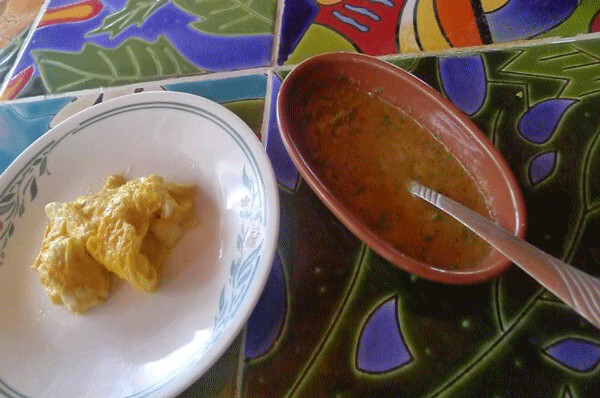News & Articles
Browse all content by date.

Santa Marta, Colombia. In a plaza near the center of town, I bought some empanadas from a small stand. The couple selling them were neatly dressed and well-groomed, looking more like college kids than refugees from Venezuela, Colombia's troubled neighbor to the east. The refugees blended in seamlessly with the strolling romancers, lounging elders, and spandex-clad exercisers, and I assumed they were locals until I saw the green sauce they served alongside their empanadas. That sauce, called guasacaca, is a part of the Venezuelan identity that they could not leave behind. And the Colombians surely feel the same thing about their red counterpart, aji picante.
Where there are chile peppers, there are sauces made from chile. And where there is chile sauce there is a choice between green and red. Red chile are fully ripened, and pack a distinct sweetness along with their heat. Green chile are picked before they ripen, and have a slightly bitter, pungent and more complex flavor.
In New Mexico, where chile lords over the local cuisine, no restaurant order is complete without a response to the official state question: "red or green?" In the northern part of South America, the red vs green divide follows the boundary between Colombia and Venezuela. Colombians take their chile via the sharp red sauce called aji picante, while Venezuelans, including the refugees in that plaza in Santa Marta, prefer the smooth green chile sauce known as guasacaca.
Where these sauces are consumed, there are as many versions of aji picante and guasacaca as there are kitchens. In both countries, their respective sauces are applied to savory substrates like beans, meat, plantains, empanadas, and even salad. Aji picante contains red chile, and sometimes tomatoes, with cilantro and onion tops being the only green components. In the case of the relatively mild guasacaca, which is sometimes called Venezuelan guacamole, the green colorcomes from bell peppers, avocado, cilantro and parsley.
The Venezuelan refugees in the Santa Marta plaza, two of about 3 million who'd been welcomed by the Colombian government, served their empanadas with a guasacaca thin enough to be squirted from a squeeze bottle. Instead of avocado, their version was thickened with powdered milk and a shot of mayo-a guasacaca recipe for a tight budget, lean as these entrepreneurial Venezuelans, but strong enough to get the job done. It added a dose of earthy green plant flavor and creaminess to nicely balance the meat filled pastry.
After discovering guasacaca, I kept my blender busy as I experimented with various formulations of this glorious green condiment. I put it on boiled yucca, pollo asado, fried fish, even leftover ceviche. But I was, after all, in Colombia, and I eventually embraced the fiery red chile sauce color of my adopted place.
Here, each restaurant visit brings a new version of aji picante to be studied, followed by my attempt to recreate it in my kitchen. Unlike guasacaca, aji picante doubles as a marinade, adding spectacular flavor to the local Colombian beef, while softening its chewy texture. The large eggs from the red chickens behind my casita, scrambled with soft chunks of local cheese, seem to have been created just for aji picante. To have a batch of aji picante on hand is all the reason one needs to cook anything. This morning I turned the tables, and put my scrambled eggs into a bowl aji picante and used them to mop it up.
Although I'm currently smitten by aji picante, the color (and texture, and flavor) of one's chile sauce is a personal thing, so I'll pass along recipes for both national sauces, assembled from what I've learned on my travels. One could do worse than to set a bowl of each upon the same table. In fact, given the current situation along the border between these red and green nations, and the generosity of the Colombians, there are surely many tables in Colombia set with both sauces.
Aji Picante
The proportions are highly subjective, and dependent on your personal taste, but here is a framework to get you started.
Serves 6
½ cup water
½ cup white vinegar (cider vinegar works too)
1 habanero, or other hot red chile, in quantity that gives you the heat you can handle and enjoy (I need to make it hot enough that my wife won't drink it all)
3 green onions, chopped
2 tablespoons olive oil
2 tablespoon lime juice
1 teaspoon salt
½ cup cilantro leaf
½ cup chopped red bell pepper
Optional: ½ cup chopped, seeded tomatoes
Add water, vinegar, chile, oil, lime juice, salt and the white parts of the onion to a blender and liquefy. Add cilantro, red bell pepper, tomatoes and onion tops. Pulse a few times to blend these final ingredients as finely as you like. Serve immediately or let sit overnight to develop the flavor. Season with vinegar.
Guasacaca
Like its red Colombian cousin, a range of proportions is acceptable in an authentic bowl of guasacaca, depending on your personal preference.
Serves 6
1 avocado
1 medium onion, chopped
2 garlic teeth, as they call cloves in these parts
1 green bell pepper
1 bunch cilantro leaves
1 bunch parsley leaves
2 tablespoons olive oil
1 tablespoon white or cider vinegar
½ teaspoon salt
½ teaspoon pepper
Add the avocado, onion, garlic, bell pepper, cilantro and parsley to a food processor, and blend. When smooth, keep blending and drizzle in the oil and then the vinegar, then add the salt and pepper. Taste, and adjust seasonings as you wish. Serve in a bowl alongside whatever else is on the menu.
| Tweet |


